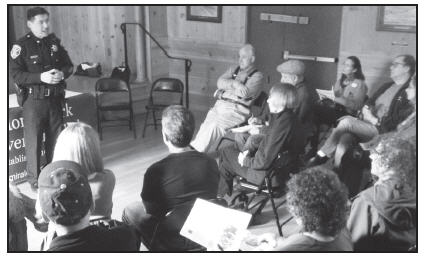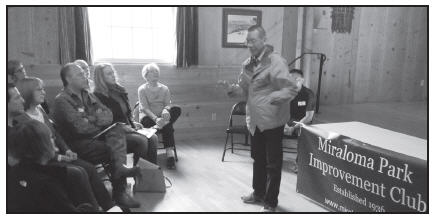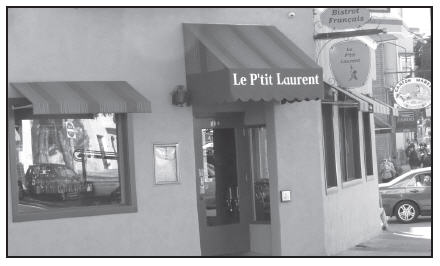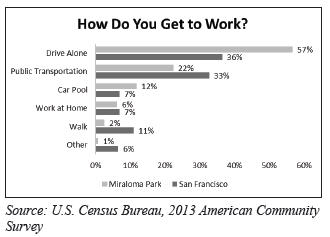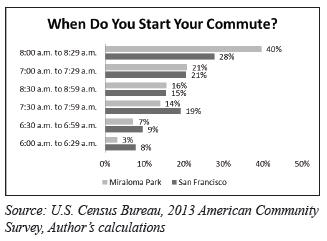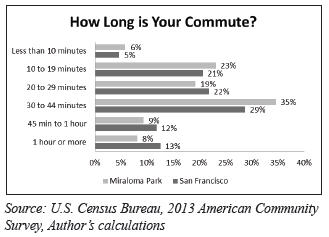News & Events
Miraloma Life: March 2015
- High-level SF Officials Meet Residents at February 7 MPIC Safety Event
- Bistro Le P’tit Laurent: A Piece of Paris in Glen Park
- Update: Crosswalk at Del Vale and O’Shaughnessy Boulevard
- Summary of the MPIC Board Meeting of February 5, 2014
- Ingredients to Become a 401(k) Millionaire
- Maintaining Property Values and Protecting Our Environment
- What’s Growing in Our Backyards?
- Neighborhood Emergency Response Team (NERT) Training Coming to Miraloma Park!
- Leave a Legacy
- The Miraloma Park Commute
- Event Notice
High-level SF Officials Meet Residents at February 7 MPIC Safety Event
by the MPIC Safety Committee
Responding to residents’ concerns about recent burglaries in Miraloma Park, the MPIC hosted a conversation about community safety with District 7 Supervisor Norman Yee and SFPD Golden Gate Division Commander Garret Tom (see photos), as well as SFSafe Public Safety Specialist Jon Shepherd, Director of Partnerships Jeremie Beebe from Nextdoor, and over 40 residents. The purpose of the meeting was to empower our residents to take the initiative in preventing crimes in Miraloma Park, and the message from all of our guest speakers was the same: our most powerful and effective weapon in combating crime may also be our least used—giving police officers the opportunity to check out suspicious activity. It’s great to be aware of and share information about suspicious activity, but actively reporting it is the key to keeping the neighborhood safe.
Miraloma Park has a low crime rate, although historically we have seen an increase in residential burglaries in January. In January 2015, four residential burglaries occurred in Miraloma Park: at a home whose owners were away for the holidays; at an unoccupied rental; at a home with no residence directly opposite; and when the home was unoccupied as a resident walked her child to school. The SFPD informs us that, prior to being burglarized, homes are usually watched, the residents’ patterns of leaving and staying at home noted, and the doorbell rung before the crime to ensure that the home is empty. Thus, most home burglaries could be prevented if neighbors conscientiously report suspicious activity like strangers ringing doorbells or sitting in cars with no apparent purpose.
Commander Tom, whose command includes the Bayview, Ingleside, Taraval, Richmond, and Park Districts, advised that residents observing these and other activities— e.g., testing security gates, looking into backyards or into cars with flashlights at night—should always report them to police by calling 553-0123 for suspicious activity or 911 for a crime in progress or appearing imminent. If the concern is about a suspicious person sitting in a car, providing the license number during the call allows Police Dispatch to check if the car is stolen, as stolen cars are typically used in crimes (as are rentals).
Supervisor Yee discussed the importance of a robust SFPD budget to support at least three Academy classes annually. Both Supervisor Yee and Commander Tom spoke about SFPD understaffing and the need for adequate funding of Academy classes. (The MPIC has been active in advocating for this funding in the City government review and approval process.) Supervisor Yee (norman.yee.bos@sfgov.org) also invited residents to take part in the District 7 Participatory Budget process.
Jon Shepherd of SFSAFE (sfsafe.org) discussed SFSAFE’s free home safety assessment program (sfsafe.org/services/home-security), which provides a home walk-through by an SFSAFE Security Specialist to identify and discuss ways of increasing the safety and security of your home. SFSAFE specialists provide a free written report of their recommendations. Jon also discussed neighborhood Safewatch groups and the tremendous safety advantages of neighbors knowing and communicating with each other.
Jeremie Beebe explained Nextdoor’s capacity to put neighbors in touch with each other and its effectiveness as a first step in bringing neighbors together in the relationship-building that is essential to a healthy community, and in the activism needed to keep the neighborhood safe. visit https://nextdoor.com/neighborhood/miralomapark–san-francisco–ca/
The MPIC gratefully thanks our guest speakers and attendees for their commitment to keeping Miraloma Park one of San Francisco’s safest neighborhoods.
Safety Note: Ingleside officers have arrested suspects in connection with the recent Miraloma Park burglaries. We’ll report further as information becomes available.
Bistro Le P’tit Laurent: A Piece of Paris in Glen Park
By Jim O’Donnell
In 2006, Laurent Legendre, an experienced restauranteur from Paris, had previously owned the successful Clementine Restaurant at Clement and 2nd Avenue and was looking for a new opportunity after taking a year off to be with his family. Looking on Craig’s List, he found a bar, the Red Rock, up for sale in Glen Park. “So where in the City could that be?” he thought. Fortunately
for the neighborhood and himself, Laurent tracked it down, checked it out, and transformed the corner of Diamond and Chenery into a bit of fresh air blowing all the way from Paris.
“That corner reminded me of La Place de la Republique in Paris,” Laurent told me, “and I wanted to recreate that Paris look and feel in Glen Park.” It took a full year to remodel, but Le P’tit
Laurent became a transplanted Paris bistro designed by Laurent himself. The darkness of the Red Rock was replaced by an upbeat, well-lit, inviting environment. “We always wanted that close-knit atmosphere that projects community, comfort, and a good place to enjoy an authentic French meal,” he explained.
French eateries are divided into bistros, brasseries, and restaurants, and you pay progressively more, mostly for improved décor, in that order. The word “brasserie” means brewery. The origin of the name “bistro” is a bit unclear. One definition derives from the Russian Army’s occupation of Paris after the defeat of Napoleon in 1815. The soldiers would shout “bystro!”—Russian for
“quickly”—when asked how fast they wanted their food. The Fleur de Lys restaurant, probably the most famous French eatery in town, recently closed, and one reason was that it was very tough to get out of there for under $200 per person. Last time your humble author was there, it cost $700 for three people for the five-course meal!
A bistro may remind you of Paris, and it’s far more affordable than a restaurant, but does it have the same look and quality of food? I’ve been to Le P’tit Laurent several times since 2007 and the menu and food preparation compares very favorably with the vaunted Fleur de Lys. Chef Julio Caceres has been at the bistro for over 4 years, after experience at other well-known SF restaurants including Postrio.
Le P’tit Laurent has an everyday fare of classic French cuisine that features a very reasonable prix fixe menu on weeknights, under $30 for an appetizer, entrée, and dessert. And you will get your meal “bystro,” for Chef Julio is committed to timely as well as delicious food. Laurent is offering an even better deal than usual from March 16 through April 15: his 2014 Tax Relief Prix Fixe Menu, saving you not just the taxes but even more, at $20.14 per meal! For more information, check out the website of this tasty bistro at leptitlaurent.net. See you there soon!
Update: Crosswalk at Del Vale and O’Shaughnessy Boulevard
Many years ago, Del Vale residents began advocating for a crosswalk across O’Shaughnessy Blvd at Del Vale. Their efforts are now finally becoming reality. Sidewalk cut-outs have now been completed at the new cross walk location and the guard rails have been modified. Connections have been completed for the installation of solar powered crossing signals that when activated will alert oncoming traffic with flashing signage and lights that pedestrians are crossing.
The proposal to add a safety island at this new crosswalk was submitted last year by a Del Vale resident as part of Supervisor Norman Yee’s participatory budget program. That proposal received the most votes from District 7 residents in the Safety and Traffic Category, but so far no construction has started on this safety island.
Summary of the MPIC Board Meeting of February 5, 2014
by Carl Schick and Dan Liberthson
On-line votes: (1) Incur up to $900 for insurance costs to hold NERT training at Cornerstone Trinity Baptist Church (R Gee, 1/18)—approved; however, T Sauvain later found insurance coverage for $232 from now through June for NERT training and other MPIC-related events at the church. (2) Incur up to $500 to repair the Clubhouse basement door (K Rawlins, 1/29)—approved. Guest: Jennifer Dolan, resident
Treasurer’s Report (T Sauvain): January net worth was $22,631, up from $21,429 in December. The current reserve total is $1018. In January, income from rentals was $3140; newsletter advertisings, $675; and membership dues, $3541. Expenses included $59 for a new Clubhouse security light, $85 for a Resiliency event, and $58 for an Intuit service to complete our contractor 1099 forms electronically. Our 2014 tax filings are complete.
Committees: Membership (B Kan)—There were 528 members as of January 31, 2015, up from 485 in December 2014. Target membership is 600 by end of 2015, to be achieved by improved communications and programming. Clubhouse Maintenance (K Rawlins)—The Clubhouse basement door has been replaced. DPW removed eucalyptus tree branches overhanging the Clubhouse parking lot. The MPIC gardener cut up the branches at no charge and is using them in the Club’s native plant garden. C Mettling-Davis did an ADA accessibility report, detailing steps and costs necessary to make the Clubhouse compliant. The Board is seeking help in gaining funding for these costs. Clubhouse porch and railings repainted by Jimmy Carlton, a Miraloma Park resident working towards his Eagle Scout badge. Safety (Committee)—See lead article in this issue. Planning (K Breslin for T Armour)—Pre-application meeting notice received for renovation at 451 Molimo. Jennifer Dolan of that address described the project and process and said everything was being done according to Planning Department requirements. Resiliency (D Homsey)— Working Group met on January 14 to review objectives and set priorities for 2015. Residents are encouraged to participate in 6-week NERT training, at the Cornerstone Trinity Baptist Church starting March 12. Community Organizations: Coalition for SF Neighborhoods (CSFN, K Breslin)—Resolution that CSFN urge the Board of Supervisors not approve the 2014 Housing Element because the validity of the EIR is still being considered by the appellate court. (passed). Resolution that CSFN support and urge legislators to support Senate Bill 47 (by State Senator, Jerry Hill of San Mateo) requiring the State to study the health impact of SBR (tire waste) infill and establish a temporary moratorium on installation of this type of infill until those studies have been completed (passed). See also newsletter at csfn.net. West of Twin Peaks Central Council (WTPCC, K Breslin)—Plan for 6000 units on the Balboa reservoir discussed; many unanswered questions.
Ingredients to Become a 401(k) Millionaire
By Bill Kan, CFA
What does it take to be a 401(k) account millionaire? Joining this select group may be easier than you think. The five ingredients are straightforward. They are to start as early as you can, get the employer match, save regularly, stay invested, and catch up if you can. Reasons why many miss the mark include not saving enough, not investing appropriately, impatience, lack of time, and behavior. Few people make it, but we should not be surprised if we hear of a $1 million account by age 52 or $2 million by age 62. Saving in any type of account is good. This article focuses on 401(k) accounts because of their helpful features.
Retirement accounts, such as 401(k)s and IRAs, are great ways to save. Like IRAs, 401(k) accounts get preferential tax treatment so savings can grow faster. Contributions may be tax-deductible. Income and gains are tax deferred and can be tax-free. 401(k)s have higher annual contribution limits than IRAs so people can save more if they want. Payroll deductions used for 401(k) contributions help instill discipline. Many companies match employee contributions, which is effectively free money. To add context, consider some facts about 401(k) balances. $9,670 is the average annual contribution for 2014 at Fidelity Investments, one of the largest providers of
401(k) accounts. The figure includes employee contributions and employer matches. At Fidelity, $92,000 was the average balance for all 401(k) accounts at the end of 2014. $248,000 is Fidelity’s average account balance for employees in a 401(k) plan for 10 years or more.
Five Steps to Becoming a 401(k) Millionaire
1. Start as early as you can to take advantage of compounding. The earlier you start, the less work you must do to become a millionaire. Compounding is how your money does more of the heavy lifting for you. Reaching a million would take about 30 years if you start from scratch, make annual contributions equal to the 2014 average of $9,670, and earn 7.2% per year on your investments. A person starting at age 22 could be a millionaire by age 52. Time and compounding make things more interesting as time passed. You could have over $2 million by age 62 and more than $4 million by 71 with continued savings strategy and the same returns. The time would be shorter if you already have savings in the account and all other conditions were the same. It would take about 23 years to grow the average 401(k) balance into $1 million. More experienced people who have accumulated a $248,000 average could expect to reach $1 million in 16 years. I’ll discuss later how contributions and investments can help people get back on track or reduce the time.
Why assume investment returns of 7.2%? First, it lets us use history as a guide, even if history may not represent the future. 7.2% is the return of a well-diversified portfolio of 60% US stocks and 40% bonds over the last 10 years. Second, it is a convenient way to introduce the Rule of 72, a simple way to think about the relationship between investment returns and wealth growth. The Rule of 72 can help gauge how fast a dollar doubles and illustrates the power of time. A dollar earning 10% per year would become 2 dollars in roughly 7.2 years. Alternatively, a dollar that grows at 7.2% per year would double in about 10 years, becoming 4 dollars in 20 years and 8 dollars in 30 years.
2. Take advantage of the employer match. Adding the average $9,670 every year in a 401(k) may be easier said than done. The employer match can account for a big portion. Many companies will match 50 cents for every dollar employees contribute. In this example, I estimate that the match will count for one-third of the total contribution. Matches are effectively free money sitting there for you to pick up. Every plan is different. It is important to understand the terms of your plan.
3. Saving regularly and living within your means are good habits for financial success. Enrolling for automatic payroll deduction for 401(k) contributions makes saving easy. Many people won’t spend income they don’t see. Regular saving and investing instills discipline and takes the emotion out of investing. A growing body of evidence shows that emotion is a big factor in why returns of individual investors are lower than expected.
4. Use an investment strategy that fits you. A well-suited investment strategy works in conjunction with your savings strategy. It should be one that you are comfortable using long-term, not something you discard in times of trouble, allowing emotion to take over. Return and risk go hand-in-hand. The risk profile is moderate for the portfolio that generated the 7.2% used in this discussion.
It is a diversified portfolio with 60% US stocks and 40% bonds. Diversification reduces risk but won’t eliminate it. Over the last 22 years, the returns of this portfolio averaged 8.3%. It averaged 10.5% in its best 10 years and 1.0% in its worst 10 years. Higher returns reduce the time needed to reach the millionaire mark. It would take 2 years less if the portfolio gained 8.3% per year and 6 years less with annual gains of 10.3%. People comfortable with more risk can shorten the time it takes to become a 401(k) millionaire, but they will need to prepare for a bumpier ride on the way there. A more risky, well-diversified portfolio should have higher average returns. The best years will likely be higher and the worst will be lower. The question for most people is whether they can live with a portfolio this volatile when things get bad.
5. Make “catch-up” contributions. Life can get in the way of the best laid savings plans. Family, school, mortgage, and other obligations can throw the best of us off track. Larger contributions can be a safer way to catch up than taking more investment risk. Someone who did not start contributing until age 35 could still become a millionaire by age 52. He or she could catch up by making the maximum contribution, using the employer match, and getting 7.2% growth on their investments. The IRS has set the 2015 limit for individual contributions at $18,000. In total, employee and employer(s) contributions cap out at $53,000. The IRS also lets people age 50 or over make an additional $6,000 contribution, taking the total up from $53,000 to $59,000. Starting from scratch and adding the maximum $59,000 every year, someone at age 50 could reach the $1 million mark in 11 years with annual investment gains of 7.2%.
Bottom Line: Though reaching the $1 million mark in your 401(k) account may sound difficult, it is doable. Even if a 401(k) is not as your primary way to save, many of the lessons discussed above still apply.
Maintaining Property Values and Protecting Our Environment
by Sue Kirkham
Everyone is aware of the high price of homes in SF and Miraloma Park, but real estate cycles are inevitable. I became an active Licensed Realtor in 1985, and have seen many dips in the market during that time. We should not be complacent in maintaining our property values, whether the market is up or down. The MPIC’s volunteers work to keep the neighborhood safe and graffiti free, which helps sustain property values, but homeowners also need to do their part. Following are some suggestions:
– Do not pave over your front yard. Paved front yards are unattractive and so lower your property value and that of your neighbors.
– Landscape your front garden area. Drought tolerant plants are easy to maintain. Hire a landscaper or gardener if needed.
– Regularly eliminate weeds in the garden, pavement, and gutter.
– Keep your home painted and well maintained.
– If you see trash on the street or sidewalk, pick it up.
We do not have street cleaning in Miraloma Park, so neighbors should make a special effort to remove any litter on the street.
Neglecting any area of your home or the space around it indicates that you don’t care how it looks, which will impact the value of your property and that of your neighbors, and can make your home more vulnerable to a break-in. Let’s all pull together to keep Miraloma Park a beautiful and safe place to live!
Yard Paving Damages the Urban Watershed
Paving all or part of your front or rear yard not only negatively affects the appearance of your home and reduces its property value, but also impacts SF’s sewer system and potentially your or your neighbor’s property. San Francisco has a combined sewer system, which collects and treats both sewage and storm water together before they are discharged to the Bay and Pacific Ocean. When heavy storms occur, treatment plants are unable to process all of the combined sewage and storm water, and it must be released untreated into the Bay and ocean.
Green Infrastructure is a program of the US Environmental Protection Agency to reduce the amount of raw sewage released into our waters. This storm-water management tool takes advantage of the natural processes of soils and plants in order to slow down and clean storm water and keep it from overwhelming the City’s sewer system. Some of the tools are permeable pavements, rain gardens, flow-through planters, rainwater harvesting, “green” and “blue” roofs, constructed wetlands, and creek daylighting. While you may not be able to install a green roof or a wetland on your property, you can help reduce the burden on our sewer system and preserve the Bay and Ocean by leaving as much unpaved space as possible on your property. This will allow rainwater to permeate the soil rather than run off into the sewers.
Another negative effect of paving is that instead of absorbing into soil rainwater may be forced into your neighbor’s property (or your own), causing damage and mold. Why not increase your property value and help the environment by landscaping with the drought tolerant plants needed by bees, butterflies, and birds for food and mating, all the while increasing the beauty of our neighborhood and reducing the raw sewage that runs into our surrounding waters? Don’t pave and use green tools.
For more information on Green Infrastructure and our watershed, please visit ((Site no longer available))
What’s Growing in Our Backyards?k
by Denise Louie
In my series of columns, I’ve tried to convey the importance of what’s growing in our backyards. If you say it’s for the birds, you’re right! As it happens, it’s for both birds and bees.
In Fall 2014, Audubon released its 7-year climate study, which was reportedly done very conservatively. Up to 50% of North American bird species are at risk of extinction by the end of the century. “By 2080 … dozens of avian species across the country could be hurtling toward extinction—and not just birds that are already in trouble” (climate.audubon.org). “314 of 588 sspecies under review are at risk of being ‘climate-endangered’ or ‘climatethreatened’— that is, they face losing more than half of their range by 2050 or 2080,” including 9 state birds. And “110 of 310 California species would experience significant range loss by 2100, including owls, pelicans, sparrows and many more birds we otherwise take for granted.” (Audubon, Sept-Oct 2014, p. 31).
What wildlife needs is habitat, i.e., plants that would grow naturally where we humans have converted land for our own purposes. So if we want to keep our birds, with their visual beauty and their songs, we need to make a solid effort to plant suitable habitat in which they can feed, breed, and raise young. As many of my past columns have explained, native plants, and preferably local native plants, serve this purpose best. As an individual, you can help sustain our birds by planting appropriate natives in your yard.
Birds need help, true, but growing a garden to nurture bees is good too! There are 63 native bee species in SF. Native bees pollinate our gardens and local farms, providing both scenic beauty and food, and we should do our best to help them out. You can find easy tips and information resources at houzz.com/ideabooks/32351570/list/how-to-design-a-garden-for-native-bees. One idea is to plant a 3 1/2 x 3-1/2 foot area with a single plant species, resulting in blocks of color that bees can see. Bees find my coast buckwheat and California poppies particularly attractive. Plant local native plants that bloom in different months of the year, so pollinators will have food sources all year round. The Oakland Museum of California has a worthwhile exhibit, Bees: Tiny Insect, Big Impact, in the Gallery of California Natural Sciences through September 20, 2015. There you can learn a lot about California plants, wildlife, and ecosystems.
At the California Native Plant Society (CPNS) sale in October, I bought two cream bush shrubs (Holodiscus discolor), which may grow to 7 feet tall and in the summer have graceful, 5-inch-long, creamy-white flower clusters. Many plants for sale occur naturally around Mt. Davidson, including the cream bush, toyon, sticky monkey flower, pearly everlasting, morning glory, duddleya, various grasses, and more.
Franciscan wallflower, a low-growing perennial with creamy flower clusters, is a rare and endangered species. So it’s a particularly good thing to give it some habitat in our gardens. Call CNPS Plant Coordinator and Chapter President Ellen Edelson at 415-531-2140 about this and other local native plants.
Trees need to be managed, including Monterey pine and cypress, which belong in Monterey, not SF where they are invasive. I regularly remove their seedlings from my backyard. Last Fall, I paid $1500 to have my neighbor’s pine tree trimmed. My primary goal was to balance the tree without killing it. The heaviest branches overhung my property, and I didn’t want the tree to fall into my
house. I also wanted more sunlight on my property, for the sake of my native plants and for potential rooftop solar panels. What I learned during this process is that trees should be trimmed every few years, to remove dead branches and so that the crown can grow in a healthy way. The bigger the tree, the more expensive it is to trim. Nigel’s Tree Service (nigelstreeservice.com) did an excellent job for me, and it was worth the investment. But there is a lesson to be learned here: before planting trees, we should consider their impact on the environment, our neighbors, and our wallets!
Perhaps you’ve heard that the SF Public Utilities Commission (SFPUC) plans to mix groundwater with Hetch Hetchy water in the not too distant future. In this light, it matters a lot what’s in our backyards. Concrete does not allow rainwater to percolate into the ground: we don’t want it in our yards because we want our groundwater to be replenished. Trees suck up a lot of groundwater, but we can use graywater for our gardens, especially for trees. Synthetic chemicals, including fertilizers, will leach into groundwater; so we should avoid using such chemicals, starting now, since we don’t want to be drinking them. This is yet another reason to replace lawns on our property with local native plants, which require less water and no synthetic chemicals.
Neighborhood Emergency Response Team (NERT) Training Coming to Miraloma Park!
The terrific energy and enthusiasm generated by participants at our 2014 Resilient Miraloma Park (RMP) strategic planning sessions brought about the SFFD’s decision to hold a NERT Training here in Miraloma Park. At our January 14 meeting, the RMP Implementation Group worked with SFFD NERT Coordinator Lt. Erica Arteseros to move forward with the plan (email sffdnert@sfgov.org or call 415-970-2002 to register). The upcoming training will be co-hosted by the MPIC and Cornerstone Trinity Baptist Church and will begin 6 pm, March 12 at the Cornerstone Church (Teresita at Arroyo).
The mission of NERT is to help the citizens of San Francisco to be self-sufficient in a major disaster situation by developing multi-functional teams cross-trained in basic emergency response. Through this program, individuals learn hands-on disaster-response skills that will help them to meet emergency challenges both at home and as members of an emergency response team adjunct to the SFFD response. In support of the NERT mission, the MPIC’s goal is to develop our team not only through NERT training, certification, and Citywide/district drills, but also through practice sessions held in Miraloma Park, enabling us to get to know our fellow team members so that we will work efficiently together when our help is needed. Each trained NERT member means one less victim to burden San Francisco’s emergency service system that is certain to be overwhelmed in a major disaster.
The NERT Training consists of six classes of approximately 3 hours each, and it is free. Previously certified NERT volunteers—come out and re-certify! Let’s restore and build our neighborhood’s ability to recover from disaster while also protecting our most vulnerable residents during times of severe stress. Please register for this critically important training, and encourage your neighbors to register, too. The last time NERT Training was held in Miraloma Park was 2008!
Leave a Legacy
by Sue Kirkham
Over 70% of Americans contribute to nonprofit groups during their lifetimes. Only 6% continue this support through a gift in their will or estate plan. Yet, by making a planned gift you can continue to help organizations that make a difference in your community. You can talk to your attorney, financial planner or accountant regarding such a gift. A professional can advise you about getting the maximum tax and legal benefits of planned gifts.
The Miraloma Park Improvement Club has an ongoing need for funds to continue our efforts to preserve our neighborhood as a safe, clean and desirable place to live, and to bring you news of the neighborhood through Miraloma Life. Advertising dollars alone do not cover the cost of the publication of this newsletter, a lifeline to disseminate important neighborhood information to you and your neighbors. The MPIC building is expensive to maintain, with insurance and other costs constantly climbing.
Your financial support of the MPIC through your annual dues is greatly needed and appreciated. But consider leaving a legacy, through a planned gift to the Miraloma Park, as a lasting gift to the neighborhood you have called home.
The Miraloma Park Commute
by Bill Kan
How would you describe your commute? In Miraloma Park, we have access to freeways. We are close to the Glen Park BART and the Forest Hill MUNI stations. The 36 MUNI bus can take us to these hubs when we don’t want to walk. This article looks at the commute from Miraloma Park using data from the 2013 American Community Survey by the US Census Bureau. The data are for Census Tract 307, which covers most of Miraloma Park.
Miraloma Park residents prefer to drive to work. About 69% of our commutes involve some form of driving, compared with 43% for San Francisco overall. More than half of drivers (57%) drive alone and another 12% carpool. Public transportation is important to Miraloma Park. Two out of five commuters rely on it for work.
Miraloma Park residents like to start their workday at the top of the hour. Sometime between 8 and 8:30 am, 40% of Miraloma Park heads out to work. The 7 to 7:30 am slot is the next most frequently traveled by Miralomans. Knowing this, it might be worth trying to leave a little earlier or later to avoid the morning rush.
Half of Miraloma Park commuters get to work in less than 30 minutes. About one-third will be on the road for 30 to 40 minutes. As someone accustomed to commutes over an hour each way, I think the typical commute from Miraloma Park is pretty sweet.
Event Notice
Right in our neighborhood, The Music Man, performed by the talented young artists from Ruth Asawa SF School of the Arts (Portola at O’Shaughnessy), 76 trombones and all. March 12-14, 19-21. All you lovers of musicals, perk up your ears!


